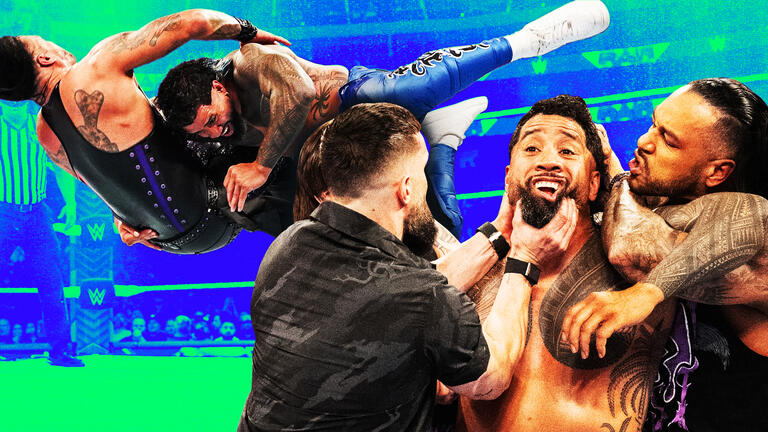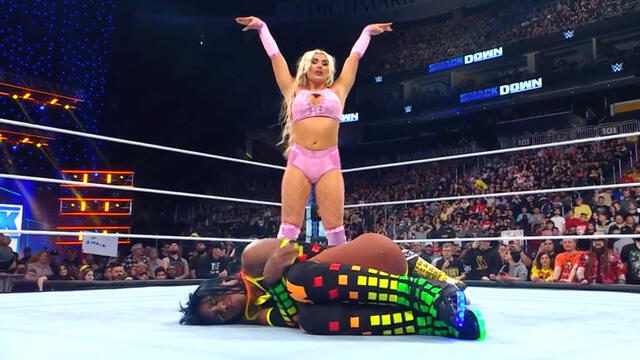
Why is it called the Garvin Stomp? 8 maneuvers named for the men who perfected them

You know that thing Randy Orton does where he methodically walks around a fallen opponent and deliberately drives the heel of his foot into select joints and muscles, targeting vulnerable areas with the sadistic focus of a Spanish inquisitor?
The 50 coolest maneuvers ever! | See these maneuvers on WWE Network
It’s called the Garvin Stomp, which almost sounds underwhelming when considering the damage the maneuver can impact upon a body, but the name is more of a nod than a stylistic choice. Where does the handle come from? Click ahead to learn the origin stories behind the Garvin Stomp and seven other eponymous maneuvers.
Garvin Stomp
If there is one move that captured just how rugged “Rugged” Ronnie Garvin was, it was the Garvin Stomp. The former NWA Champion’s famed Stomp is as simple as it is effective and can be applied in a few easy steps:
1. Approach vulnerable opponent lying on the mat. Stomp shoulder.
2. Go to the waist … STOMP!
3. Head to the knee … STOMP!
Notice a pattern here? Garvin kept stomping away at his vulnerable opponent and brutalized many of his foes to defeat with this vicious and straightforward maneuver. You may have noticed the Garvin Stomp in WWE rings as Randy Orton brought the iconic maneuver back to the squared circle, exacting precise punishment on rivals like John Cena and Daniel Bryan with the heel of his boot. — TOM LIODICE
Who invented Randy Orton's RKO?
LeBell Lock
It’s known as The “Yes!” Lock today, but when Daniel Bryan first started dislocating shoulders with his go-to submission hold, he named the maneuver after the man who invented it — Gene LeBell. Purported to be the most dangerous fighter alive at the peak of his abilities, LeBell competed in the first televised MMA contest in 1963 (he won), and officiated the historic bout between Antonio Inoki and Muhammad Ali.
LeBell did not hand the move to Bryan directly. The former WWE Champion learned it from his grappling coach, Neil Melanson, who trained under LeBell. Still, “Judo” Gene shared his gratitude with being recognized for the maneuver in a 2010 interview with WWE.com.
"It's nice when you get credit," LeBell said. "It's not as good as five dollars cash, but it makes me happy."
Learn more about how Daniel Bryan adopted the LeBell Lock
Uncle Gene — as he’s often called — is still scrapping today at 81 and can regularly be seen in the corner of UFC Women's Bantamweight Champion “Rowdy” Ronda Rousey — although we’re still waiting for her to hook a LeBell Lock on someone. — RYAN MURPHY
Thesz Press
Lou Thesz is widely considered to be one of the greatest grapplers of all time, but did you know he is also one of the most innovative? The man who held the NWA Championship longer than anyone else was credited with inventing the powerbomb, STF and the appropriately named Lou Thesz Press.
Where does Lou Thesz rank amongst the toughest wrestlers ever?
Thesz finished many opponents during his 3,749 combined days as NWA Champion with his famous Press in which he jumped towards his foe, knocking him to the mat and pinning him in a body scissors.
The move regained popularity in the mid-to-late ’90s when “Stone Cold” Steve Austin introduced the Thesz Press to his repertoire, adding a series of punches to his fallen victim. Randy Orton, Trish Stratus and Kaitlyn have all used the Lou Thesz Press in the ring to pay tribute to the former champ. — T.L.
Asai Moonsault
You may have seen this maneuver performed by WWE’s best high flyers over the years. With their opponent dazed on the outside of the ring, the Superstar goes to the apron, jumps onto the middle rope and uses it as a springboard to backflip onto his victim. This move is known as the Asai Moonsault.
Learn how the Cruiserweight Title changed the game
The label may fool people, as it’s branded after this famous grappler’s birth name, Yoshihiro Asai. He is better known as Ultimo Dragon, one of the greatest cruiserweights of all time. Credited by many as its innovator, the former WCW Cruiserweight Champion’s Asai Moonsault has become a popular move used by numerous WWE competitors such as Shawn Michaels, Rey Mysterio, Lita and Aguila (pictured above). Chris Jericho’s signature Lionsault is a variation of the maneuver. — MIKE MURPHY
Frankensteiner
Credit for the innovation of the hurricanrana goes to lucha libre icon Huracán Ramírez (hence the name). Just don’t let Scott Steiner hear you say that.
During a sit-down interview with Mike Tenay in July 2000, Big Poppa Pump directly addressed the WCW announcer’s penchant for calling the move a hurricanrana instead of a Frankensteiner, shouting, “I don’t give a damn about luchadores! It’s a Frankensteiner! Call it the Frankensteiner!”
See Scott Steiner spike Brian Knobbs with a Frankensteiner
The maneuvers were similar, but Steiner’s version of the headscissors takedown always felt so much more impactful than a hurricanrana. Where the lucha variety would send a victim arcing high into the air, the Frankensteiner drilled the target’s head directly into the mat with scary velocity. When performed by a competitor as physically unbelievable as Steiner, it really was something deserving of its own classification.
So let’s all just call it the Frankensteiner, huh? — R.M.
Gory Special
Although it’s now known more for its numerous deviations, the Gory Special is a classic submission maneuver created by the patriarch of the Guerrero family and father to WWE Hall of Famer Eddie Guerrero, Gory Guerrero.
Using the hold as his finishing maneuver, Gory would get back to back with his opponent and lock his arms before lifting him up and leaning forward, stretching his opponent’s back over his own. All Guerreros, including Eddie, have kept the Gory Special in their arsenals as a secret weapon. Former Superstar and grandson of Gory, Chavo Guerrero, uses the Gory Bomb — a facebuster modification also created by Gory — as his finisher.
Other variations include the Barry White Driver, Stu Hart Special and former Diva Victoria’s Widow’s Peak. — M.M.
Michinoku Driver
This one’s tricky, because the natural assumption would be that the Michinoku Driver is named for Taka Michinoku. In truth, it gets its name from innovator The Great Sasuke. Confused? Well, Sasuke originally competed under the name Masa Michinoku. When Taka Michinoku began wrestling in Japan, he adopted the Michinoku name in a nod to Sasuke. To add to the mix-up, Taka also created his own versions of the Michinoku Driver, which he called Michinoku Driver II and II-b.
Where is Taka Michinoku today?
The Michinoku Driver II — a scoop slam piledriver that drops an opponent on his neck and shoulder —is also sometimes called the Michinoku Driver. Taka used this vicious slam to defeat Brian Christopher in 1997, becoming the first-ever WWE Light Heavyweight Champion. In recent years, the Michinoku Driver has been picked up and altered by competitors like Cesaro, making it one of the most reinvented moves in the industry. — SCOTT TAYLOR
Funk Spinning Toehold
The Spinning Toe Hold is a maneuver that goes way back in the annals of wrestling history. While 1950s mat standout Walter Palmer is often credited with inventing the hold, it’s The Funks — Dory Sr. and his sons, Dory Jr. and Terry — that made the submission technique their own. Dory Jr. used the finishing hold to win the NWA World Heavyweight Championship from Gene Kiniski in 1969.
If you watch closely, you can still see the maneuver’s influence in the ring today. When Superstars such as Ric Flair and The Miz slap on the Figure-Four Leglock, they are actually applying a modified Funk Spinning Toehold at the beginning of the move.
See the Funk Spinning Toehold in action
When locking in the hold, a Funk would stand over a fallen competitor, twisting his leg inwards as they turned 360 degrees. Oftentimes, they would step over their opponent’s leg multiple times while wrenching his knee and ankle, causing unbearable pain. — S.T.
WWE Shows Latest Results
SmackDown results, April 19, 2024: Tiffany Stratton introduces Bayley and Naomi to Tiffy Time with a sneak attack
Full ResultsNXT Spring Breakin' 2024 Week One results: Trick Williams slays The Mad Dragon to become NXT Champion
Full Results




















